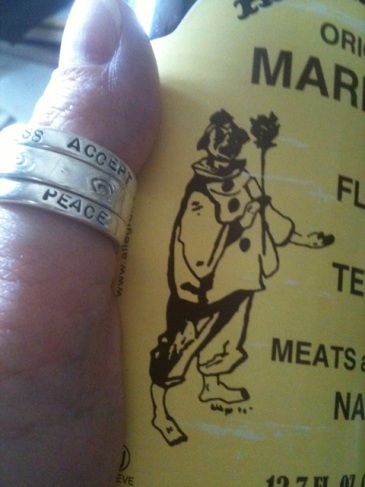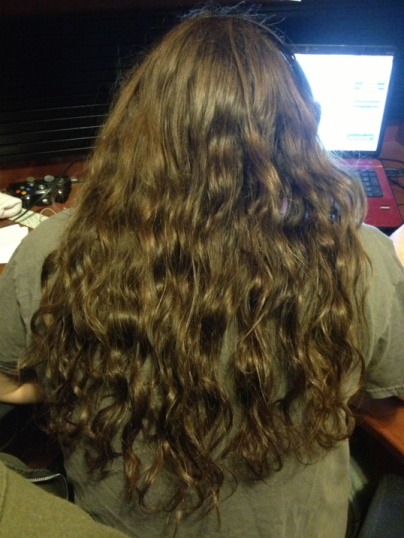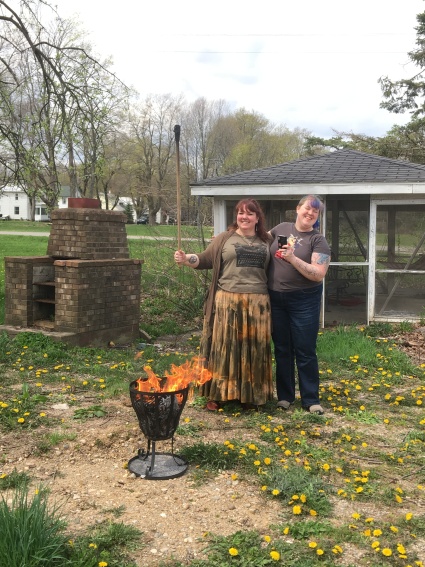
I recently did a presentation on writing realistic dialogue for my local writers group. I decided to go ahead and post it here in case people who had to miss the meeting wanted a chance to read it. Then I thought you guys might like it, too. And if you end up singing Ten Duel Commandments to yourself for the rest of the day, you’re welcome.
And here are links if you missed parts one and two.
Well-written dialogue is an amazing multipurpose tool – it’s a heavy-lifter. It’s the Swiss Army knife in a writer’s toolbox. It can convey character, emotion, and motivation all in a few carefully chosen words. It can also drive the plot. Poorly written dialogue is also a tool – usually a sledgehammer beating against the reader’s head.
It’s no secret that acquiring editors frequently scan for dialogue in submissions. And when it doesn’t work, they often pass on a manuscript without reading further.
I’ll admit that when I was working as an acquisitions editor, I always made a point to see how the author handled dialogue. If it was rife with the dialogue sins we’re about to discuss, the author received a rejection letter. If the dialogue had potential, I’d read more of the story and possibly send a revise and resubmit letter. If the dialogue was solid and engaging, I’d often read the entire submission. The moral of this story is that good dialogue will get you a lot farther.
#5 Thou shalt eavesdrop. (But thou shalt only use some of what you hear.)
Often when you overhear conversations, they’re bland and mundane.
“Hey, Sally. How are you?”
“Oh, fine, Bethany. How about you?”
“Good. Busy with kids summer activities.”
(Bethany launches into the litany of all the things she’s overscheduled her kids for this summer while Sally hopes that a sinkhole in the grocery store parking lot will open up beneath her feet to end the conversation.)
See also:
“Steve? Is that you?”
“Oh, hey, Carol how are you? Haven’t seen you in ages.”
“Good. What about you?”
“Can’t complain. You still working for the government?”
“Yep. Rain, sleet, and snow and all that.”
“Right, right.”
“You still at the bank?”
“Sure am. Going on fifteen years, now.”
(Both parties begin to shuffle awkwardly and wish that Carol had never recognized Steve or spoken to him, because now they’re both in small talk hell, and neither of them knows how to extricate themselves without making it more awkward and uncomfortable.)
These are conversations that happen every. single. day. No one wants to have them. They definitely don’t want to read them. And most importantly, painfully mundane conversations like this usually don’t move the story forward—unless of course Bethany decides to beat Sally to unconsciousness with that bag of frozen chicken in her cart. If not, in terms of the narrative, neither of these dialogue snippets have a point.
Sometimes you hear awesome stuff when you’re eavesdropping, like the two little old ladies in the booth behind me at Applebee’s arguing about who was better: Beyoncé or Katy Perry. It was one of the funniest and most adorable conversations I’ve ever heard. I don’t know if it’ll make it into a book, but those old ladies might.
The most important thing about eavesdropping is to pay attention to the way people talk. Listen to the words they use. To the rhythm of their speech. How do they talk to one another? Do they politely wait their turn or do they interrupt? Do they cry or storm off? Now think about your characters and their personalities. How will they behave in conversations?
Now, listen to the words they use. If they’re like 99.9999999999999% of the population, they’re using contractions. They’re using them all over the place. And honestly? So should you. If you’re writing predominantly native English speakers, I promise you, they’re all using contractions.
The only exception is if they’re making a point. For instance, “I will not bungee jump off that bridge.”
I’ve heard some people, who are active in Nano groups, suggest that you should avoid using contractions because it’ll up your word count.
Please don’t. Just…don’t. Avoiding the use of contractions makes dialogue sound clunky, stilted, and unnatural. This goes for contemporary novels as well as historicals.
I’ve had clients tell me that they’re not using contractions because people in the “olden days” didn’t use them. I beg to differ. Shakespeare, anyone? People have been using contractions since they wrote on cave walls. Why? Because people are lazy. Inherently lazy. If there’s an easier, quicker way to say something, that’s how we’ll say it. The same goes for your characters.
Exceptions could be made for non-native English speakers. Often, when English is a second language, the use of contractions takes a bit longer to catch on. Or, if you had a character that was painfully formal, you could choose not to use contractions for that person.
Please remember that use of contractions extends to characters internal thoughts and POV narrative, too.
While you’re listening to the way people speak, listen to how they use one another’s names.
It’s super common to see exchanges like this in fiction:
“I said I’m not going. Just leave it, Charles.”
“C’mon Abbi. She really wants to see you.”
“No, Charles. I said forget it. Your grandmother’s obsession with Katy Perry is more than I can take right now.”
“I don’t know why have to be this way, Abbi.”
I think you’ll agree that sounds a bit ridiculous. But, I’ve seen it time and time again in books.
Really listen to the people you interact with regularly. How often do they use your name while speaking to you? How often do you use theirs? I’m guessing that unless they’re trying to make a point or attempting to get your attention, it’s not often.
A good rule of thumb is no more than once per character per chapter – unless it’s one of the above exceptions. Making a point or getting their attention.
The best thing you can do for yourself to make sure your dialogue reads as naturally as possible is read it out loud. I know, no one likes doing that. I hate it, too. But it’s one of the very best methods for gauging the naturalness of your dialogue. It’s even better if you can get a friend to help you read the back and forth dialogue exchanges.
#6 Thou shalt not permit characters to speak aloud to themselves (or others) ad nauseam.
This is one of those things that I call clients on all the time. Especially the characters that talk to themselves. The response is almost inevitably: but I talk to myself all the time. Yep, me too. But not for full sentences or paragraphs.
I’ll frequently speak aloud to myself when I hurt myself, realize that I dropped a stitch three rows ago, burn supper, or lose pages of edits (or worse, writing!) because Word is being a bastard.
But when I talk (out loud) to myself, it’s a word or three at most. Usually all expletives.
I don’t launch into anything that sounds like, “For real, Bron? I can’t believe you stubbed your toe on the floor fan. Afuckingain. And broke your toe. Again. It’s not like that fan hasn’t been in the same spot for the last ten summers. Honestly, you’re the worst.”
Nope. What’s going to come out of my mouth is a blistering, but probably creative, curse word.
However, and this is an important distinction to make, the above rant about the location of the floor fan may very well be my internal dialogue. And that’s the difference. I’m talking to myself, but I’m not saying all that aloud. The vast majority of people don’t. But I promise, most of them are having lively conversations with themselves in their heads.
Often, when authors employ the technique of characters speaking aloud to themselves it’s with the intent to have one character convey information to another character that she wouldn’t otherwise share but that the author wants the reader and the other character to know.
You’ll often find sections, particularly in romance, where the heroine will say something like: “You can do this, Molly. You can go out there and face him. It doesn’t matter that you’ve been in love with him since seventh grade, and he’s always been out of your league. You can go out there and have a perfectly reasonable conversation with him and help him with his home décor issues.”
Inevitably, the hero of the story will overhear her and discover that she’s always had a thing for him which is the author’s way of advancing the plot and creating romantic tension.
Spoiler alert: this is not the way to advance the plot or create romantic tension. I mean, sure, you can use it. But this is an example of something a lot of editors would flag as lazy writing. There are plenty of other more interesting, believable, and satisfying ways for the hero of the story to discover that the heroine has long had feelings for him.
Another common example of a character speaking aloud to herself is to deliver backstory, and it goes a little something like this: “I can’t believe my rickety old truck picks now to break down on the way to the one town I swore I’d never go back to, Sketchy Hollow. The town that’s chock full of cowboys and hardly any women.”
There are tons of better ways to get the backstory across.
And just a note on the examples. I used the heroine as the character who spoke aloud to herself because in all my years of reading and editing, I think I’ve maybe seen a male character do this once or twice, but for some reason, female characters do it all the time. I’m not sure what that says about us other than perhaps we’re uncomfortable having women owning their feelings and if they can do it in an accidental reveal it’s somehow more acceptable? I’m not sure, but that’s a whole ‘nother topic.
The take away here is if your characters are talking to themselves, it’s much more effective to make that internal dialogue as opposed to spoken. If you’re trying to give a second character insight into the first, you’re better off finding a different way to do that.
And just a brief note on monologues. Usually, when you hear the word, monologue, you think Shakespeare or earnest students writing and performing one act plays for their senior thesis at some liberal arts college. However, I often see what constitutes monologues in fiction.
This is when one of the characters in a conversation with another character, talks at length. Often for paragraphs with no action or thoughts. Just a wall of dialogue. The other characters might as well not even be in the room. It’s as if the character is trying not to forget every last thing he ever wanted to say to this other person. And it’s usually followed up with a wall of dialogue from the other character responding to the first character point by point. In order.
There are times when one character is doing most of the talking. Maybe they’re trying to explain how their grand plan went so terribly wrong. Or they’re sharing some painful past history or asking forgiveness and listing all the ways they’ve fucked up. But the key is to break up that speech with action (from both the POV character and the other character) and thought (from the POV character).
That’s it for this week. If you’d like to know more about the Ten Dialogue Commandments, please check back next Tuesday!










